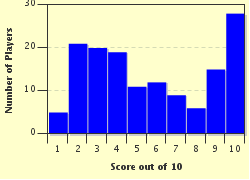Quiz Answer Key and Fun Facts
1. Introduced from Japan in the 1920s, this small bird is olive green in color and has a distinctive white ring around the eye. He is active and quick-moving, constantly searching for insects, nectar and fruit. During nesting season he wreaks havoc in my yard by picking apart the basketball net, hammock, and fiber door mat! He is also known by his Japanese name, Mejiro.
2. This fellow was introduced to Hawaii from India in 1865 to help control insect pests. He is brownish-black in color with yellow legs and bill. He has a dashing patch of yellow skin around the eyes. He is very social and noisy, preferring to hang out in a flock so he and his friends can taunt the other birds (and sometimes even my cat!).
3. This bird came to Hawaii in 1929 from the eastern U.S., where he is a familiar sight. The male is all-red with a small black patch around the bill; females are a dull tan color with a red tint on wings, tail and crest. They are frequent diners at my feeder. Hmmm...I wonder if they ever go home to St. Louis for a visit?
4. Native to South America, this lovely bright yellow bird was introduced to Hawaii in the 1960s. Males and females look alike and always seem to travel in pairs. They are shy around other birds and people,only visiting my yard when there is no other activity going on. They enjoy foraging in tall grass for insects and seeds, so when they visit my husband knows it is time to get out the lawnmower!
5. This tiny bird is gray-brown in color with a decidedly uncommon red mask around his eyes, which makes him look like a little bandit. He travels in a large flock with his friends. He is native to Africa and was first noticed in Hawaii in the late 1970s. Was he a stowaway? No one knows for sure, but he is a charming addition to Hawaii's bird community.
6. Native to Indonesia, this small bird first came to Hawaii in the 1860s, then re-introduced in the 1960s. He has a gray body, black tail and head, conspicuous white cheeks and a red bill. He travels in a large flock of friends and frequently overwhelms the feeder, scolding the other birds and not sharing the seed.
7. To put it delicately, this black bird had a distinctive red patch on his private parts! He also has a spiky crest,black bill and legs, and a white tail band underneath. Males and females look alike. He is a bold fellow who will swoop in for picnic leftovers before all the other birds. He is considered a agricultural pest here in Hawaii due to his fondness for orchid buds and fruits.
8. This 10"-12" bird was introduced from Asia in the mid-1800s. He is grayish-brown with a rosy breast and a distinctive white-spotted band around the neck. Males and females look alike, and make a pleasing series of coos. Their courtship involves the male performing an elaborate dance with much bowing, strutting and tail flaring, while the female appears to look disinterested...
9. Native to Asia, this bird was an unauthorized cage release around 1965. He is white below, dark brown above, and has white cheeks with a debonair red patch. He has a black crest and a red vent. He sings a beautiful morning song, but like his cousin the red-vented bulbul he is considered an agricultural pest.
10. This attractive bird came to Hawaii all the way from Brazil in 1930. He has a gray back, white belly, and a beautiful red head. Unlike his mainland cousin, males and females look alike.
Source: Author
missmuumuu
This quiz was reviewed by FunTrivia editor
crisw before going online.
Any errors found in FunTrivia content are routinely corrected through our feedback system.

